Managing Change: A Case Study of Bow Valley Manufacturing and River Valley Manufacturing
VerifiedAdded on 2023/06/03
|9
|1728
|398
AI Summary
This essay discusses the case of Bow Valley Manufacturing and River Valley Manufacturing and provides recommendations for handling the change. It includes steps for launching, maintaining, and communicating the change.
Contribute Materials
Your contribution can guide someone’s learning journey. Share your
documents today.
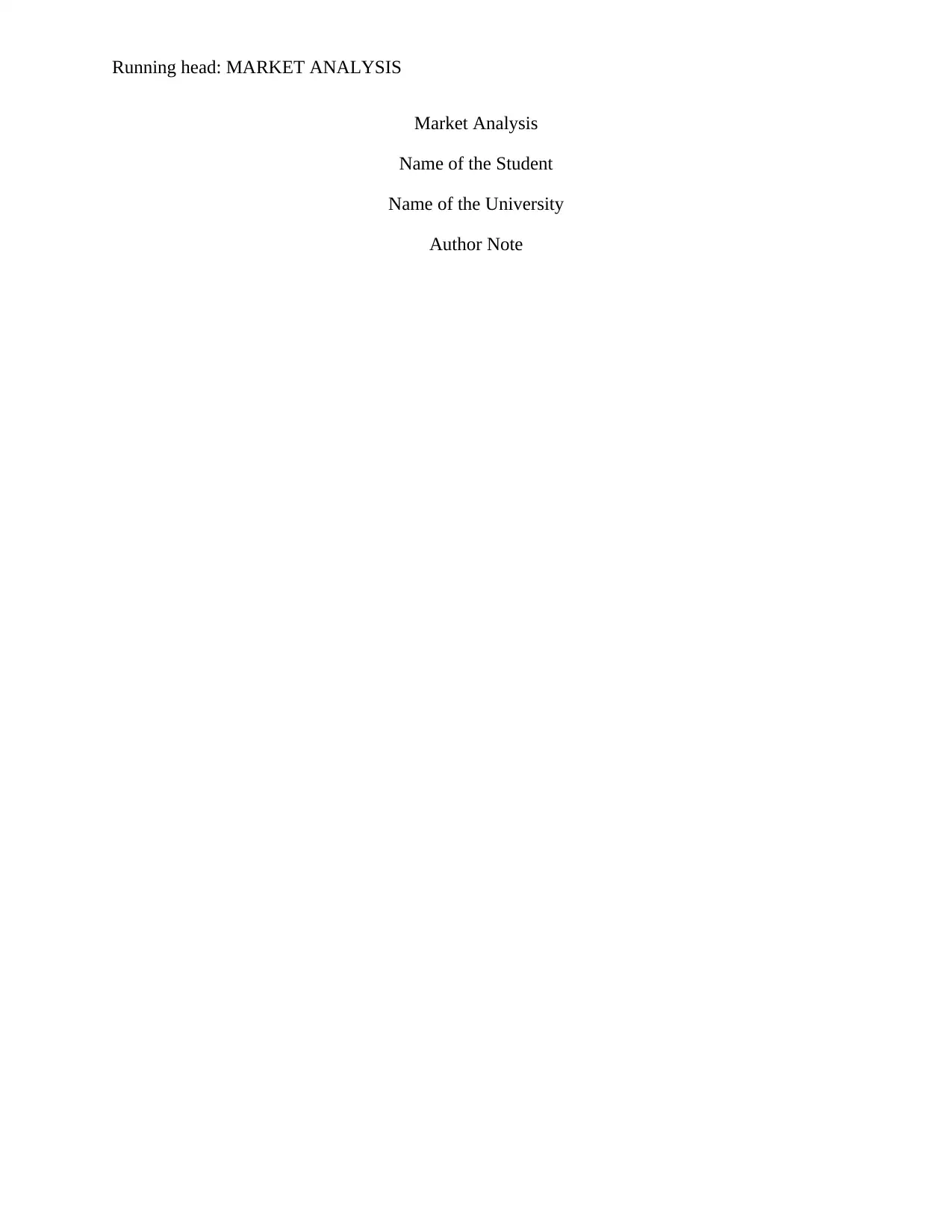
Running head: MARKET ANALYSIS
Market Analysis
Name of the Student
Name of the University
Author Note
Market Analysis
Name of the Student
Name of the University
Author Note
Secure Best Marks with AI Grader
Need help grading? Try our AI Grader for instant feedback on your assignments.
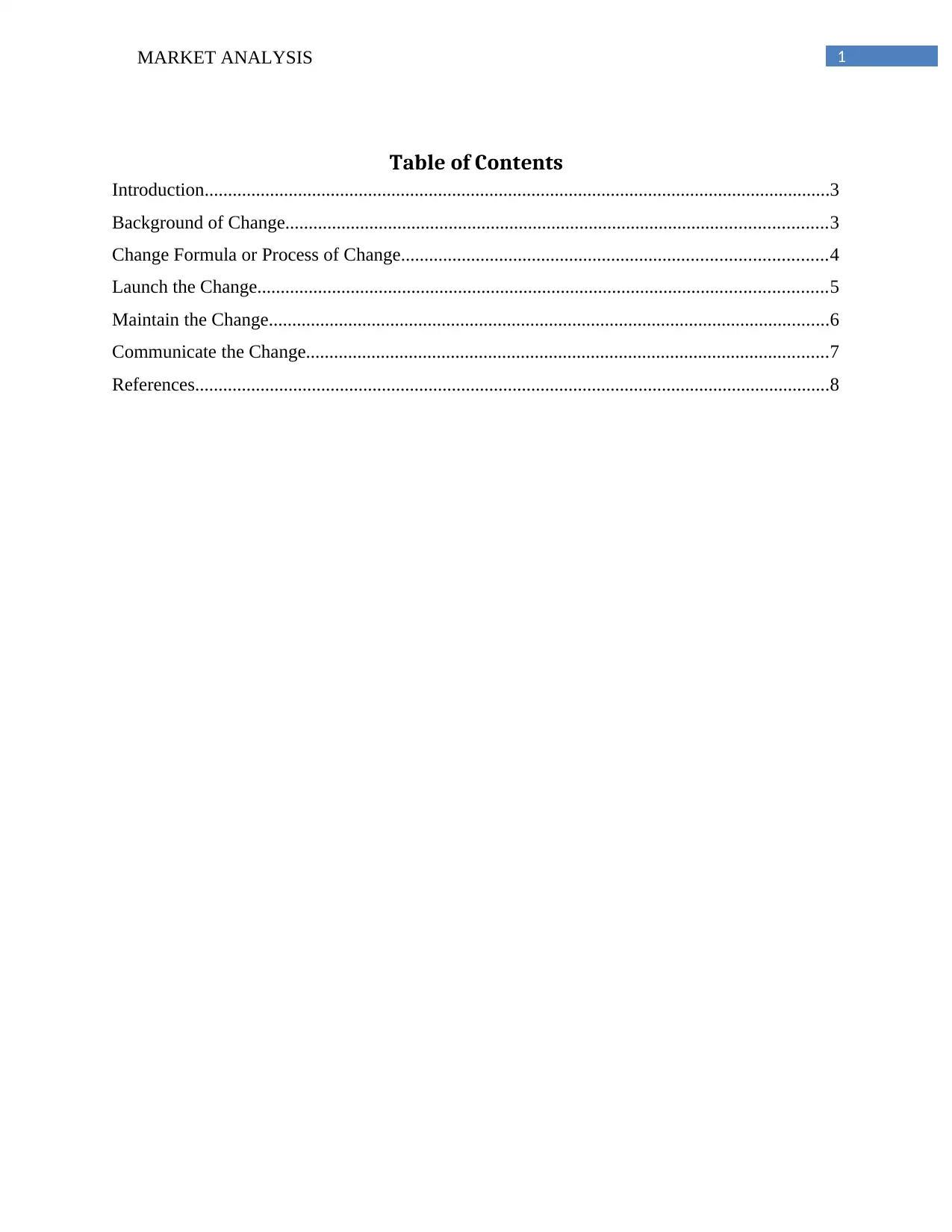
1MARKET ANALYSIS
Table of Contents
Introduction......................................................................................................................................3
Background of Change....................................................................................................................3
Change Formula or Process of Change...........................................................................................4
Launch the Change..........................................................................................................................5
Maintain the Change........................................................................................................................6
Communicate the Change................................................................................................................7
References........................................................................................................................................8
Table of Contents
Introduction......................................................................................................................................3
Background of Change....................................................................................................................3
Change Formula or Process of Change...........................................................................................4
Launch the Change..........................................................................................................................5
Maintain the Change........................................................................................................................6
Communicate the Change................................................................................................................7
References........................................................................................................................................8
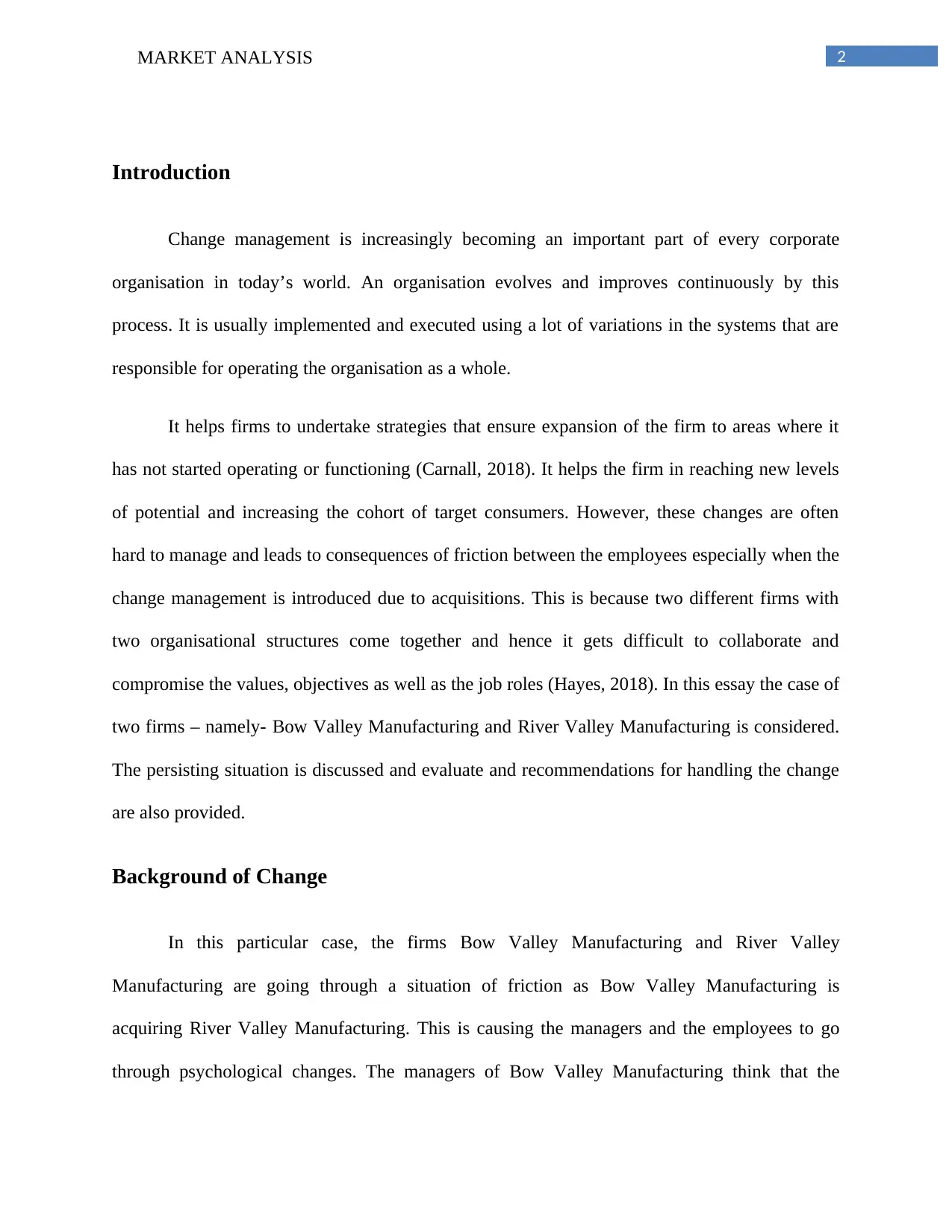
2MARKET ANALYSIS
Introduction
Change management is increasingly becoming an important part of every corporate
organisation in today’s world. An organisation evolves and improves continuously by this
process. It is usually implemented and executed using a lot of variations in the systems that are
responsible for operating the organisation as a whole.
It helps firms to undertake strategies that ensure expansion of the firm to areas where it
has not started operating or functioning (Carnall, 2018). It helps the firm in reaching new levels
of potential and increasing the cohort of target consumers. However, these changes are often
hard to manage and leads to consequences of friction between the employees especially when the
change management is introduced due to acquisitions. This is because two different firms with
two organisational structures come together and hence it gets difficult to collaborate and
compromise the values, objectives as well as the job roles (Hayes, 2018). In this essay the case of
two firms – namely- Bow Valley Manufacturing and River Valley Manufacturing is considered.
The persisting situation is discussed and evaluate and recommendations for handling the change
are also provided.
Background of Change
In this particular case, the firms Bow Valley Manufacturing and River Valley
Manufacturing are going through a situation of friction as Bow Valley Manufacturing is
acquiring River Valley Manufacturing. This is causing the managers and the employees to go
through psychological changes. The managers of Bow Valley Manufacturing think that the
Introduction
Change management is increasingly becoming an important part of every corporate
organisation in today’s world. An organisation evolves and improves continuously by this
process. It is usually implemented and executed using a lot of variations in the systems that are
responsible for operating the organisation as a whole.
It helps firms to undertake strategies that ensure expansion of the firm to areas where it
has not started operating or functioning (Carnall, 2018). It helps the firm in reaching new levels
of potential and increasing the cohort of target consumers. However, these changes are often
hard to manage and leads to consequences of friction between the employees especially when the
change management is introduced due to acquisitions. This is because two different firms with
two organisational structures come together and hence it gets difficult to collaborate and
compromise the values, objectives as well as the job roles (Hayes, 2018). In this essay the case of
two firms – namely- Bow Valley Manufacturing and River Valley Manufacturing is considered.
The persisting situation is discussed and evaluate and recommendations for handling the change
are also provided.
Background of Change
In this particular case, the firms Bow Valley Manufacturing and River Valley
Manufacturing are going through a situation of friction as Bow Valley Manufacturing is
acquiring River Valley Manufacturing. This is causing the managers and the employees to go
through psychological changes. The managers of Bow Valley Manufacturing think that the
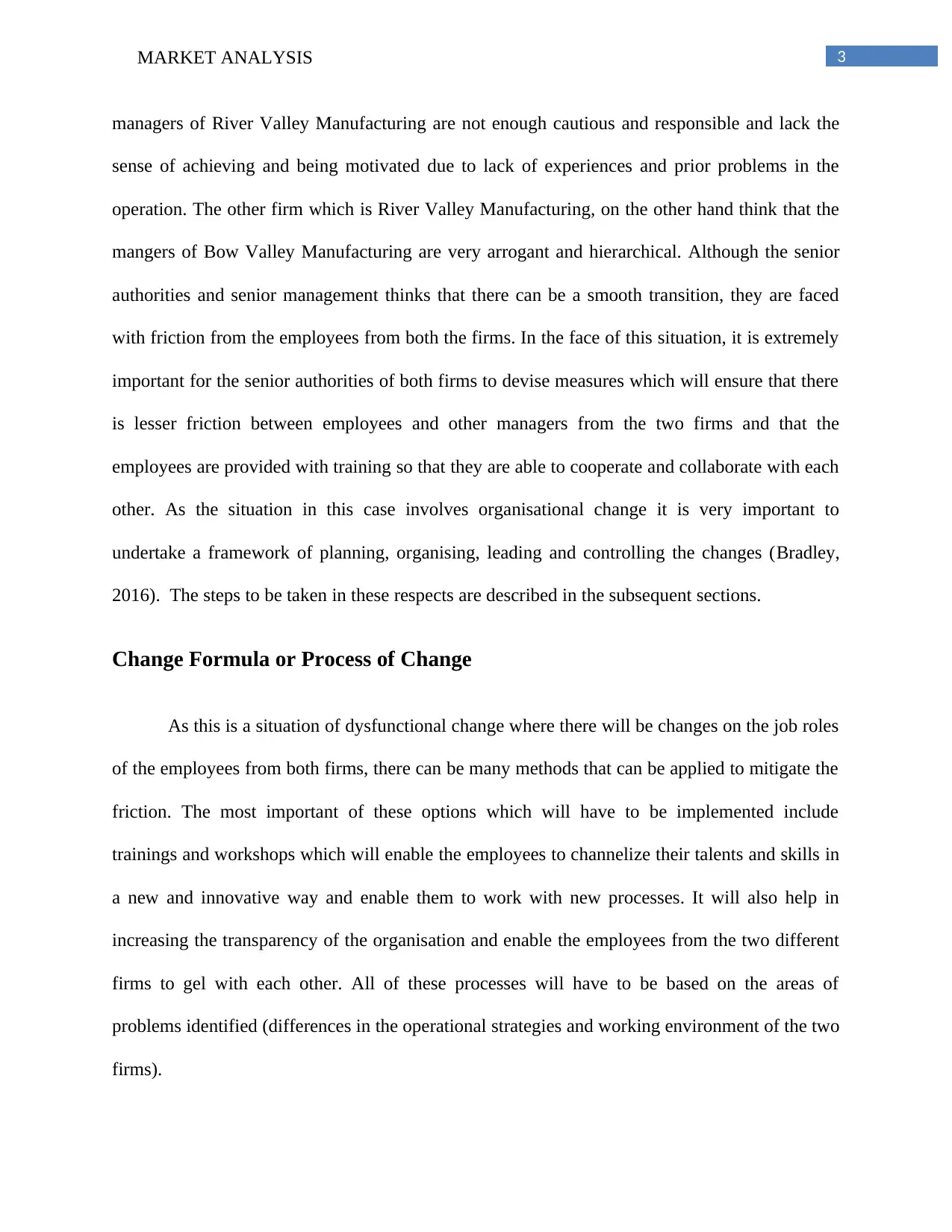
3MARKET ANALYSIS
managers of River Valley Manufacturing are not enough cautious and responsible and lack the
sense of achieving and being motivated due to lack of experiences and prior problems in the
operation. The other firm which is River Valley Manufacturing, on the other hand think that the
mangers of Bow Valley Manufacturing are very arrogant and hierarchical. Although the senior
authorities and senior management thinks that there can be a smooth transition, they are faced
with friction from the employees from both the firms. In the face of this situation, it is extremely
important for the senior authorities of both firms to devise measures which will ensure that there
is lesser friction between employees and other managers from the two firms and that the
employees are provided with training so that they are able to cooperate and collaborate with each
other. As the situation in this case involves organisational change it is very important to
undertake a framework of planning, organising, leading and controlling the changes (Bradley,
2016). The steps to be taken in these respects are described in the subsequent sections.
Change Formula or Process of Change
As this is a situation of dysfunctional change where there will be changes on the job roles
of the employees from both firms, there can be many methods that can be applied to mitigate the
friction. The most important of these options which will have to be implemented include
trainings and workshops which will enable the employees to channelize their talents and skills in
a new and innovative way and enable them to work with new processes. It will also help in
increasing the transparency of the organisation and enable the employees from the two different
firms to gel with each other. All of these processes will have to be based on the areas of
problems identified (differences in the operational strategies and working environment of the two
firms).
managers of River Valley Manufacturing are not enough cautious and responsible and lack the
sense of achieving and being motivated due to lack of experiences and prior problems in the
operation. The other firm which is River Valley Manufacturing, on the other hand think that the
mangers of Bow Valley Manufacturing are very arrogant and hierarchical. Although the senior
authorities and senior management thinks that there can be a smooth transition, they are faced
with friction from the employees from both the firms. In the face of this situation, it is extremely
important for the senior authorities of both firms to devise measures which will ensure that there
is lesser friction between employees and other managers from the two firms and that the
employees are provided with training so that they are able to cooperate and collaborate with each
other. As the situation in this case involves organisational change it is very important to
undertake a framework of planning, organising, leading and controlling the changes (Bradley,
2016). The steps to be taken in these respects are described in the subsequent sections.
Change Formula or Process of Change
As this is a situation of dysfunctional change where there will be changes on the job roles
of the employees from both firms, there can be many methods that can be applied to mitigate the
friction. The most important of these options which will have to be implemented include
trainings and workshops which will enable the employees to channelize their talents and skills in
a new and innovative way and enable them to work with new processes. It will also help in
increasing the transparency of the organisation and enable the employees from the two different
firms to gel with each other. All of these processes will have to be based on the areas of
problems identified (differences in the operational strategies and working environment of the two
firms).
Secure Best Marks with AI Grader
Need help grading? Try our AI Grader for instant feedback on your assignments.
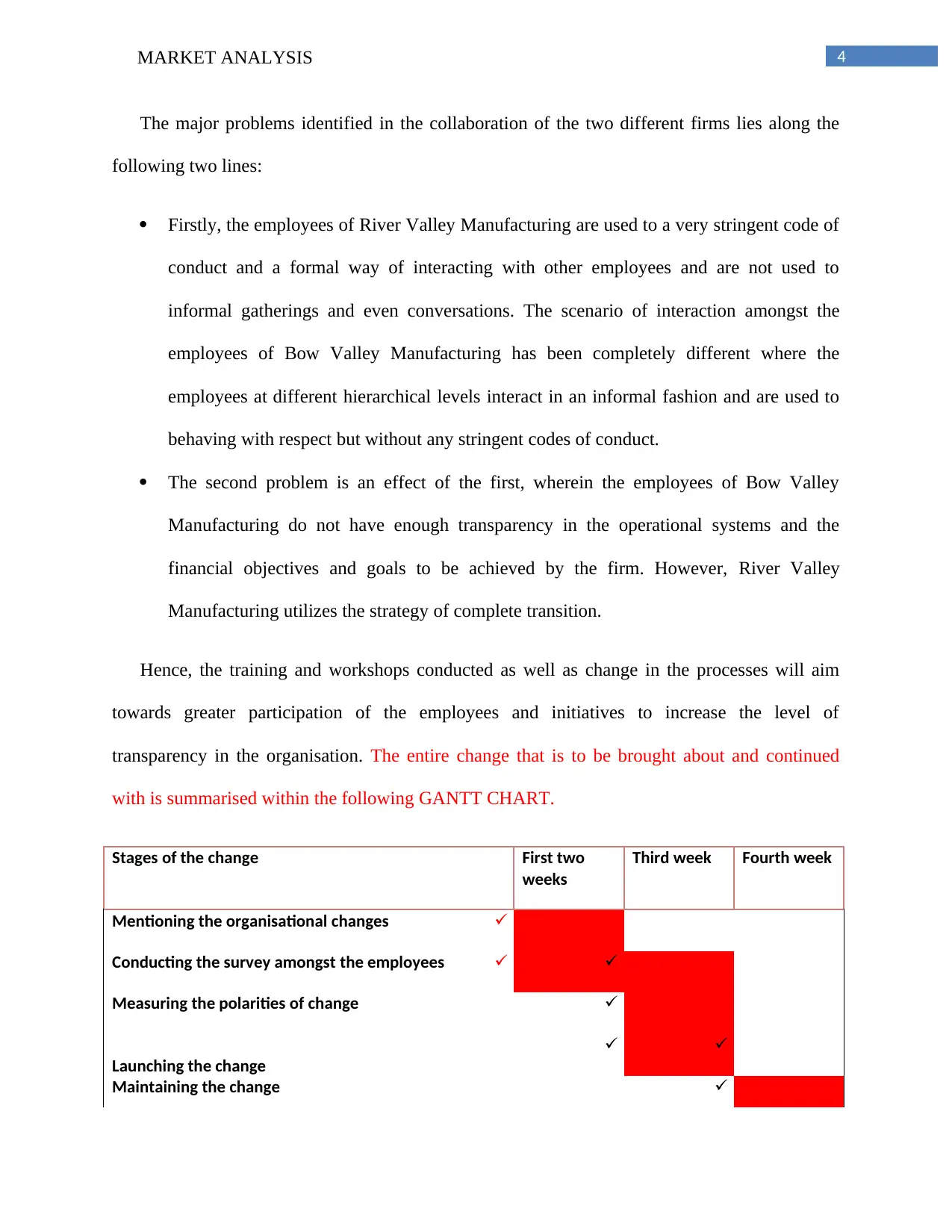
4MARKET ANALYSIS
The major problems identified in the collaboration of the two different firms lies along the
following two lines:
Firstly, the employees of River Valley Manufacturing are used to a very stringent code of
conduct and a formal way of interacting with other employees and are not used to
informal gatherings and even conversations. The scenario of interaction amongst the
employees of Bow Valley Manufacturing has been completely different where the
employees at different hierarchical levels interact in an informal fashion and are used to
behaving with respect but without any stringent codes of conduct.
The second problem is an effect of the first, wherein the employees of Bow Valley
Manufacturing do not have enough transparency in the operational systems and the
financial objectives and goals to be achieved by the firm. However, River Valley
Manufacturing utilizes the strategy of complete transition.
Hence, the training and workshops conducted as well as change in the processes will aim
towards greater participation of the employees and initiatives to increase the level of
transparency in the organisation. The entire change that is to be brought about and continued
with is summarised within the following GANTT CHART.
Stages of the change First two
weeks
Third week Fourth week
Mentioning the organisational changes
Conducting the survey amongst the employees
Measuring the polarities of change
Launching the change
Maintaining the change
The major problems identified in the collaboration of the two different firms lies along the
following two lines:
Firstly, the employees of River Valley Manufacturing are used to a very stringent code of
conduct and a formal way of interacting with other employees and are not used to
informal gatherings and even conversations. The scenario of interaction amongst the
employees of Bow Valley Manufacturing has been completely different where the
employees at different hierarchical levels interact in an informal fashion and are used to
behaving with respect but without any stringent codes of conduct.
The second problem is an effect of the first, wherein the employees of Bow Valley
Manufacturing do not have enough transparency in the operational systems and the
financial objectives and goals to be achieved by the firm. However, River Valley
Manufacturing utilizes the strategy of complete transition.
Hence, the training and workshops conducted as well as change in the processes will aim
towards greater participation of the employees and initiatives to increase the level of
transparency in the organisation. The entire change that is to be brought about and continued
with is summarised within the following GANTT CHART.
Stages of the change First two
weeks
Third week Fourth week
Mentioning the organisational changes
Conducting the survey amongst the employees
Measuring the polarities of change
Launching the change
Maintaining the change
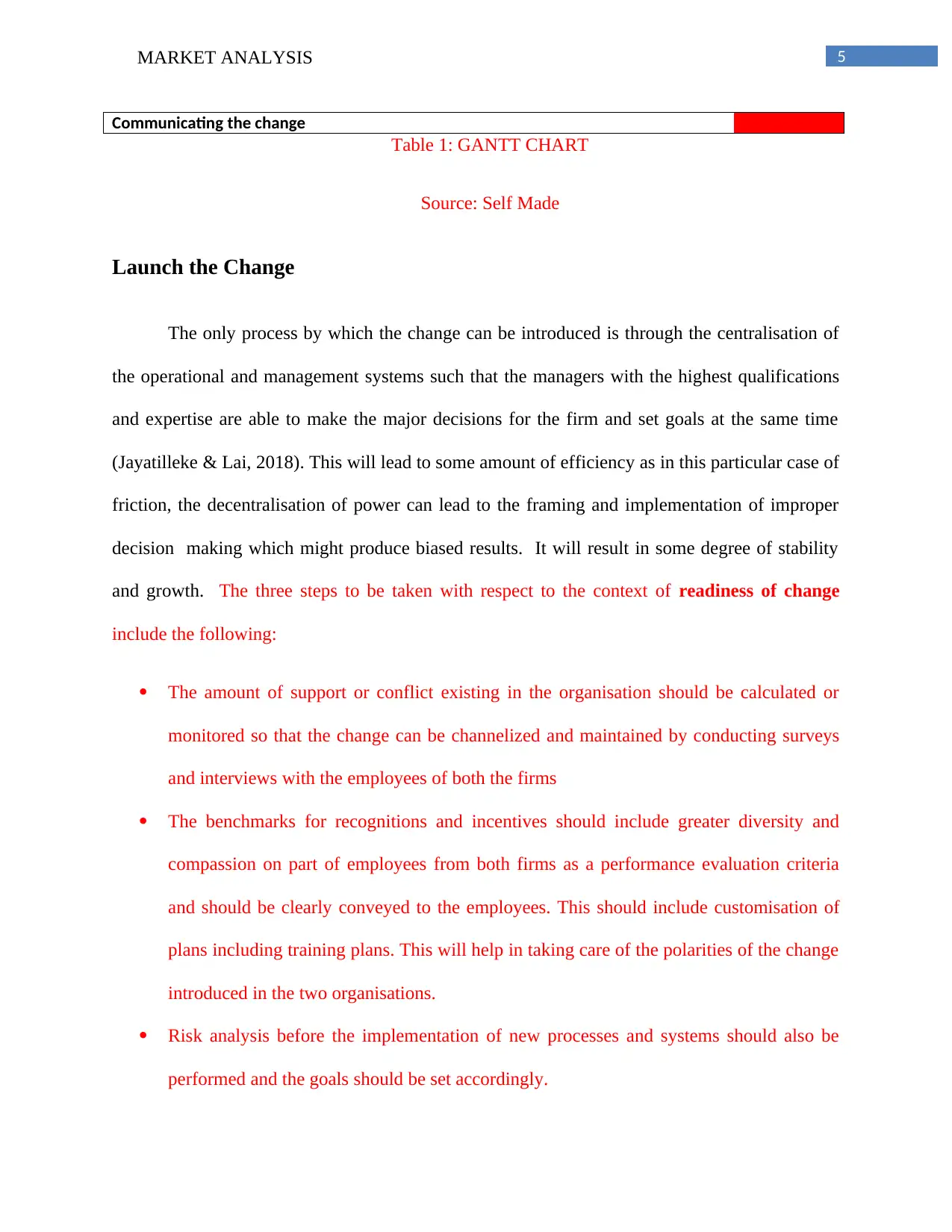
5MARKET ANALYSIS
Communicating the change
Table 1: GANTT CHART
Source: Self Made
Launch the Change
The only process by which the change can be introduced is through the centralisation of
the operational and management systems such that the managers with the highest qualifications
and expertise are able to make the major decisions for the firm and set goals at the same time
(Jayatilleke & Lai, 2018). This will lead to some amount of efficiency as in this particular case of
friction, the decentralisation of power can lead to the framing and implementation of improper
decision making which might produce biased results. It will result in some degree of stability
and growth. The three steps to be taken with respect to the context of readiness of change
include the following:
The amount of support or conflict existing in the organisation should be calculated or
monitored so that the change can be channelized and maintained by conducting surveys
and interviews with the employees of both the firms
The benchmarks for recognitions and incentives should include greater diversity and
compassion on part of employees from both firms as a performance evaluation criteria
and should be clearly conveyed to the employees. This should include customisation of
plans including training plans. This will help in taking care of the polarities of the change
introduced in the two organisations.
Risk analysis before the implementation of new processes and systems should also be
performed and the goals should be set accordingly.
Communicating the change
Table 1: GANTT CHART
Source: Self Made
Launch the Change
The only process by which the change can be introduced is through the centralisation of
the operational and management systems such that the managers with the highest qualifications
and expertise are able to make the major decisions for the firm and set goals at the same time
(Jayatilleke & Lai, 2018). This will lead to some amount of efficiency as in this particular case of
friction, the decentralisation of power can lead to the framing and implementation of improper
decision making which might produce biased results. It will result in some degree of stability
and growth. The three steps to be taken with respect to the context of readiness of change
include the following:
The amount of support or conflict existing in the organisation should be calculated or
monitored so that the change can be channelized and maintained by conducting surveys
and interviews with the employees of both the firms
The benchmarks for recognitions and incentives should include greater diversity and
compassion on part of employees from both firms as a performance evaluation criteria
and should be clearly conveyed to the employees. This should include customisation of
plans including training plans. This will help in taking care of the polarities of the change
introduced in the two organisations.
Risk analysis before the implementation of new processes and systems should also be
performed and the goals should be set accordingly.
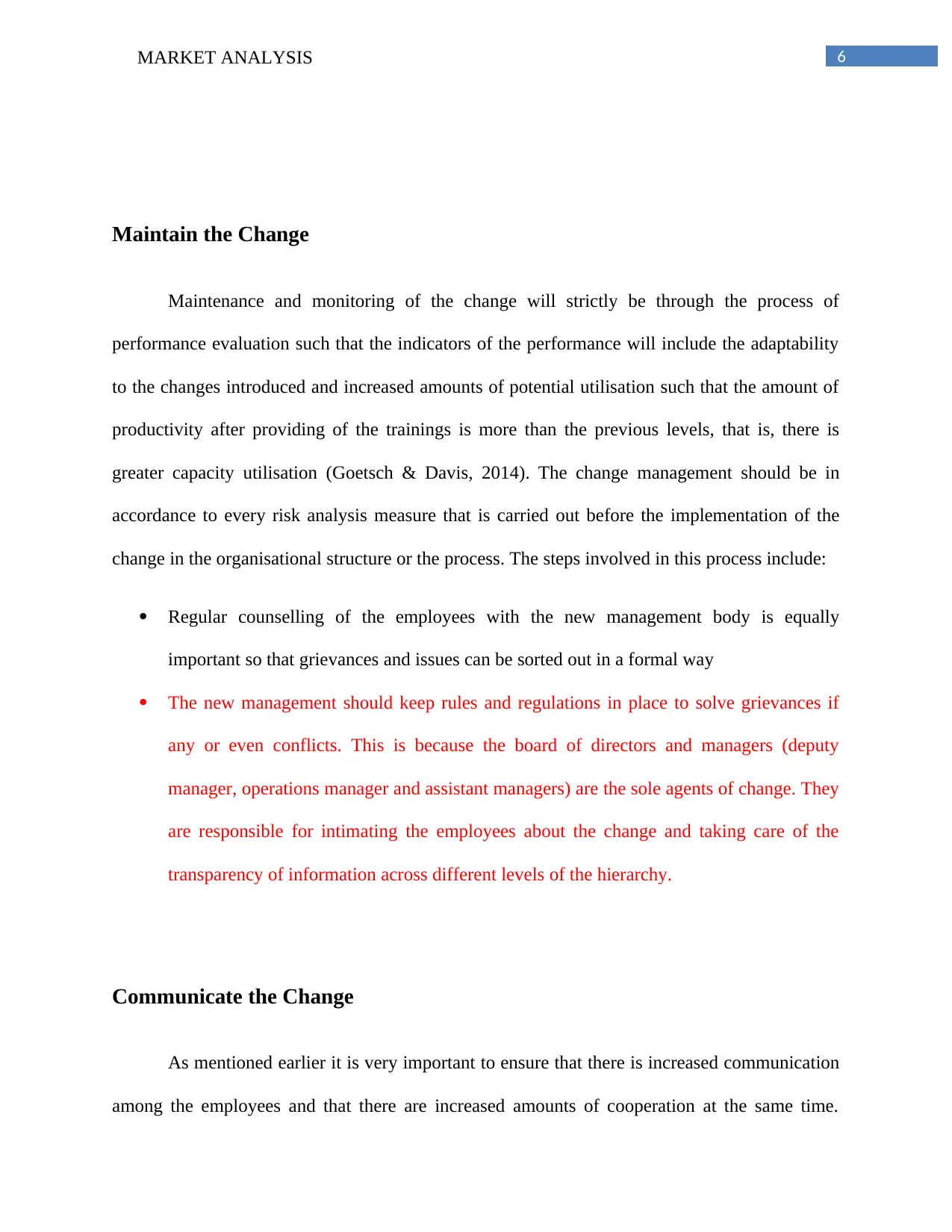
6MARKET ANALYSIS
Maintain the Change
Maintenance and monitoring of the change will strictly be through the process of
performance evaluation such that the indicators of the performance will include the adaptability
to the changes introduced and increased amounts of potential utilisation such that the amount of
productivity after providing of the trainings is more than the previous levels, that is, there is
greater capacity utilisation (Goetsch & Davis, 2014). The change management should be in
accordance to every risk analysis measure that is carried out before the implementation of the
change in the organisational structure or the process. The steps involved in this process include:
Regular counselling of the employees with the new management body is equally
important so that grievances and issues can be sorted out in a formal way
The new management should keep rules and regulations in place to solve grievances if
any or even conflicts. This is because the board of directors and managers (deputy
manager, operations manager and assistant managers) are the sole agents of change. They
are responsible for intimating the employees about the change and taking care of the
transparency of information across different levels of the hierarchy.
Communicate the Change
As mentioned earlier it is very important to ensure that there is increased communication
among the employees and that there are increased amounts of cooperation at the same time.
Maintain the Change
Maintenance and monitoring of the change will strictly be through the process of
performance evaluation such that the indicators of the performance will include the adaptability
to the changes introduced and increased amounts of potential utilisation such that the amount of
productivity after providing of the trainings is more than the previous levels, that is, there is
greater capacity utilisation (Goetsch & Davis, 2014). The change management should be in
accordance to every risk analysis measure that is carried out before the implementation of the
change in the organisational structure or the process. The steps involved in this process include:
Regular counselling of the employees with the new management body is equally
important so that grievances and issues can be sorted out in a formal way
The new management should keep rules and regulations in place to solve grievances if
any or even conflicts. This is because the board of directors and managers (deputy
manager, operations manager and assistant managers) are the sole agents of change. They
are responsible for intimating the employees about the change and taking care of the
transparency of information across different levels of the hierarchy.
Communicate the Change
As mentioned earlier it is very important to ensure that there is increased communication
among the employees and that there are increased amounts of cooperation at the same time.
Paraphrase This Document
Need a fresh take? Get an instant paraphrase of this document with our AI Paraphraser
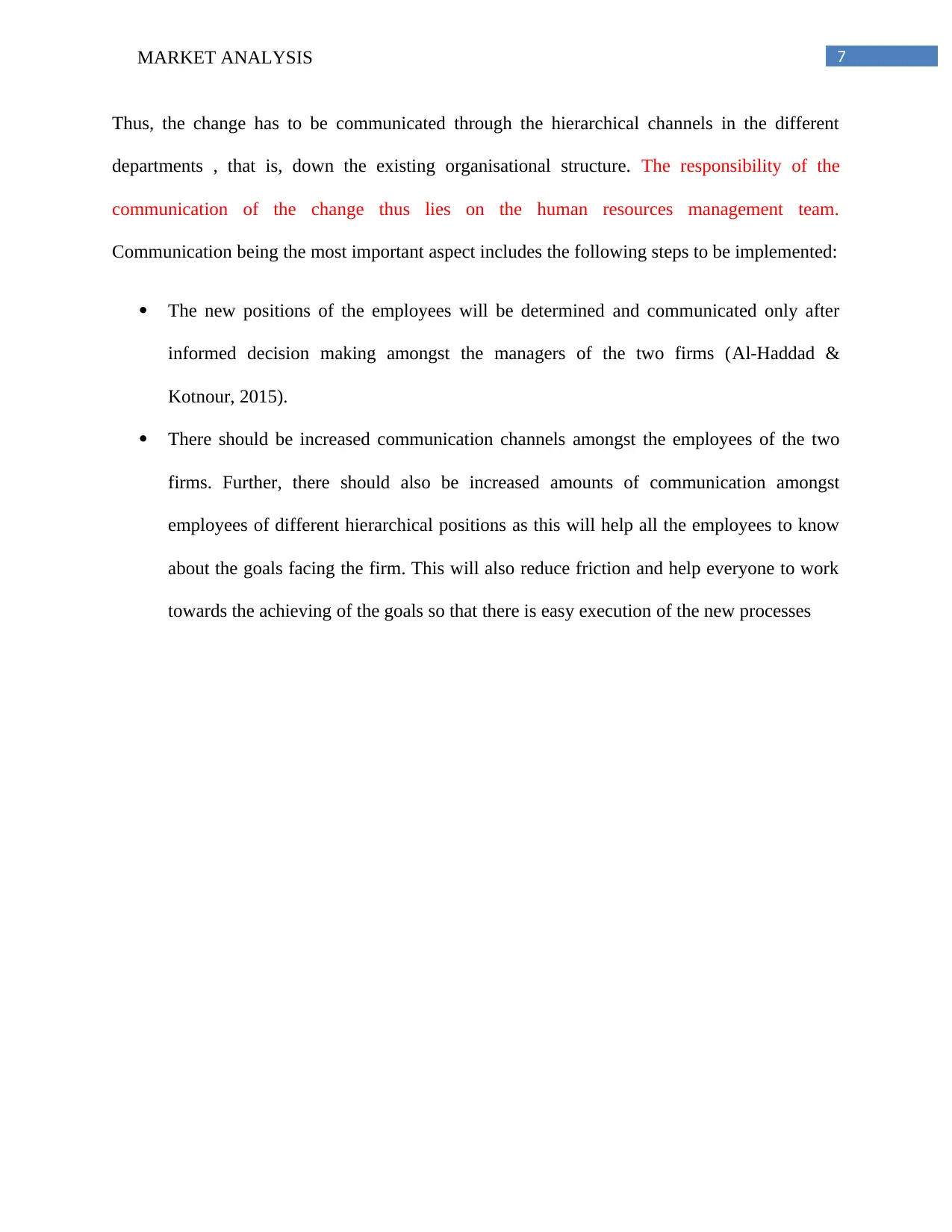
7MARKET ANALYSIS
Thus, the change has to be communicated through the hierarchical channels in the different
departments , that is, down the existing organisational structure. The responsibility of the
communication of the change thus lies on the human resources management team.
Communication being the most important aspect includes the following steps to be implemented:
The new positions of the employees will be determined and communicated only after
informed decision making amongst the managers of the two firms (Al-Haddad &
Kotnour, 2015).
There should be increased communication channels amongst the employees of the two
firms. Further, there should also be increased amounts of communication amongst
employees of different hierarchical positions as this will help all the employees to know
about the goals facing the firm. This will also reduce friction and help everyone to work
towards the achieving of the goals so that there is easy execution of the new processes
Thus, the change has to be communicated through the hierarchical channels in the different
departments , that is, down the existing organisational structure. The responsibility of the
communication of the change thus lies on the human resources management team.
Communication being the most important aspect includes the following steps to be implemented:
The new positions of the employees will be determined and communicated only after
informed decision making amongst the managers of the two firms (Al-Haddad &
Kotnour, 2015).
There should be increased communication channels amongst the employees of the two
firms. Further, there should also be increased amounts of communication amongst
employees of different hierarchical positions as this will help all the employees to know
about the goals facing the firm. This will also reduce friction and help everyone to work
towards the achieving of the goals so that there is easy execution of the new processes
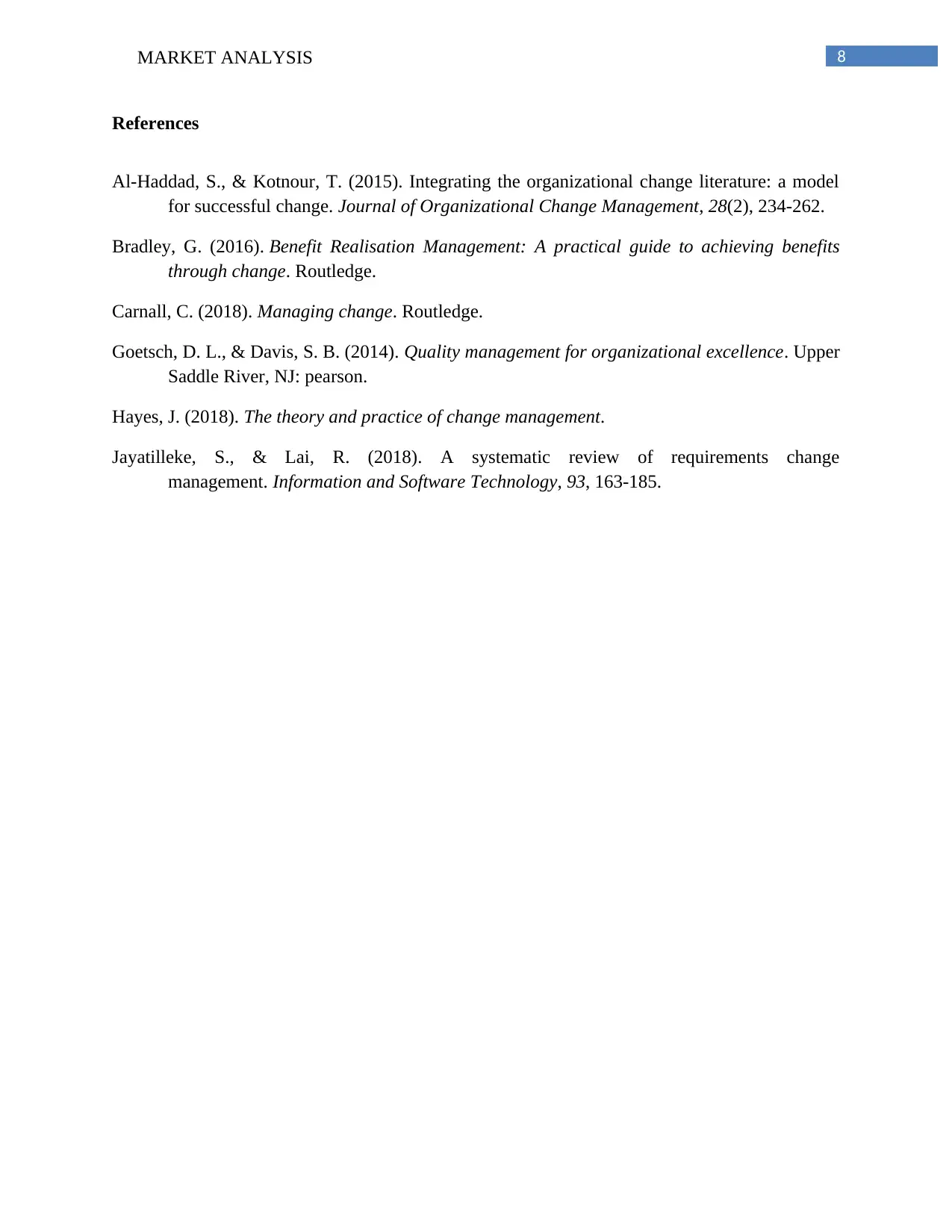
8MARKET ANALYSIS
References
Al-Haddad, S., & Kotnour, T. (2015). Integrating the organizational change literature: a model
for successful change. Journal of Organizational Change Management, 28(2), 234-262.
Bradley, G. (2016). Benefit Realisation Management: A practical guide to achieving benefits
through change. Routledge.
Carnall, C. (2018). Managing change. Routledge.
Goetsch, D. L., & Davis, S. B. (2014). Quality management for organizational excellence. Upper
Saddle River, NJ: pearson.
Hayes, J. (2018). The theory and practice of change management.
Jayatilleke, S., & Lai, R. (2018). A systematic review of requirements change
management. Information and Software Technology, 93, 163-185.
References
Al-Haddad, S., & Kotnour, T. (2015). Integrating the organizational change literature: a model
for successful change. Journal of Organizational Change Management, 28(2), 234-262.
Bradley, G. (2016). Benefit Realisation Management: A practical guide to achieving benefits
through change. Routledge.
Carnall, C. (2018). Managing change. Routledge.
Goetsch, D. L., & Davis, S. B. (2014). Quality management for organizational excellence. Upper
Saddle River, NJ: pearson.
Hayes, J. (2018). The theory and practice of change management.
Jayatilleke, S., & Lai, R. (2018). A systematic review of requirements change
management. Information and Software Technology, 93, 163-185.
1 out of 9
Related Documents
Your All-in-One AI-Powered Toolkit for Academic Success.
+13062052269
info@desklib.com
Available 24*7 on WhatsApp / Email
![[object Object]](/_next/static/media/star-bottom.7253800d.svg)
Unlock your academic potential
© 2024 | Zucol Services PVT LTD | All rights reserved.





